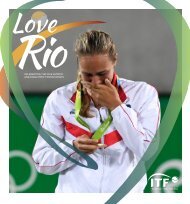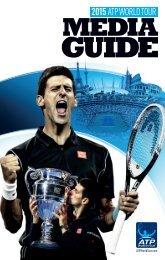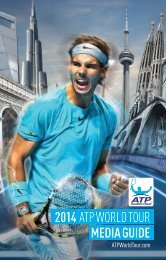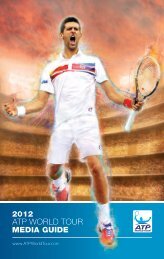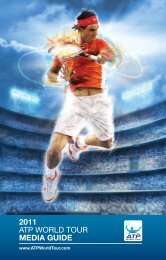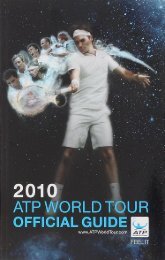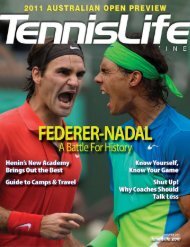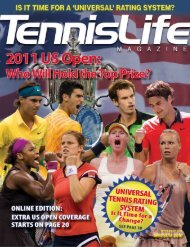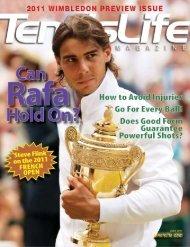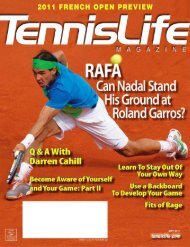A Champion's Mind - Pete Sampras
www.tennismoscow.me Insta:TENNISMOSCOW
www.tennismoscow.me Insta:TENNISMOSCOW
Create successful ePaper yourself
Turn your PDF publications into a flip-book with our unique Google optimized e-Paper software.
PATRICK RAFTER (12–4) . . . Pat was a great volleyer who took me out of my comfort zone and forced me<br />
to hit too many passing shots and thread-the-needle service returns. In terms of hard-charging opponents, I<br />
preferred to play Stefan Edberg, even though Edberg won more Grand Slam titles and had a better record.<br />
With Edberg, you knew where the serve was going and you knew he was coming to the net. You knew<br />
what you had to do, and if you didn’t execute it well enough, you lost. End of story.<br />
With Pat it was different; he mixed it up a lot more, especially with his serve. He kept you on edge,<br />
made you get into guessing games. The serve to the body is one of the most neglected shots in tennis;<br />
everybody, including me, likes to smoke aces or unreturnables to the corners. But the kick serve to the<br />
body is a great tool, and Pat was a master at it. The way to beat Pat was to make him play. He liked set<br />
pieces—kicker to the backhand, first volley crosscourt, second volley (or overhead) for the winner. If you<br />
could disrupt the pattern and find a way to make him play points, you could get on top of him.<br />
Pat won the U.S. Open twice, and in one stretch at Wimbledon he made the semis followed by two<br />
straight finals (he lost to me in one, then became the foil for Goran Ivanisevic’s long-delayed triumph at<br />
Wimbledon). Pat retired—prematurely, many thought—shortly after that loss to Goran. But Pat was like<br />
one of those NFL running backs who averages six or seven yards per carry for five or six years and<br />
suddenly falls off the radar, averaging one and a half for the next few years. That happens because those<br />
backs just get beat up and softened up; they lose a little something. That’s what I think happened to Pat.<br />
Pat had to work very hard to win his matches, for reasons having to do with his style and technique.<br />
Many of the things I said about Lleyton Hewitt apply to Rafter as well, although they had very different<br />
styles and did their grinding in dramatically different ways. Rafter was a serve-and-volley daredevil, a<br />
great mover and athlete always flying around the court, lunging, spearing volleys, making those jointbruising<br />
changes of direction. It’s just awfully difficult to work that hard for four or five years and keep<br />
coming back for more.<br />
Pat won matches by attacking the net and then, when receiving, scraping by from the backcourt, always<br />
looking for a way to get to the net. He hit his kicker with a lot of effort, kind of contorted. It wasn’t as<br />
limber and easy a delivery as Edberg’s. He worked very hard to hold, because even though he loved to<br />
rush the net, he didn’t have a huge serve—hence the reliance on the kicker (or American twist). Unlike<br />
other successful attackers, Pat couldn’t pop the aces and service winners to make his life easier. Pat<br />
fought and struggled for everything he got.<br />
MARCELO RIOS (2–0) . . . Rios was an odd one, a surly, strange sort of guy who had a lot of talent but<br />
seemed a misfit and an outsider on the tour. It’s hard to enjoy life and survive on the tour that way. Rios<br />
moved in an easy, natural way, with a terrific two-handed backhand and great shotmaking ability. He was<br />
like a left-handed Andre Agassi. He was a great striker of the ball and could take it early, but he didn’t<br />
serve as big as Andre and his game lacked the heft that made you feel like you were really in trouble. I<br />
always felt like Rios had nothing that could hurt me.<br />
Still, Rios was very creative and “handsy”—he could change direction and pace on his shots with ease,<br />
and he just had a nice feel for the ball, and the game in general. Some people touted Rios as the Second<br />
Coming, but I never saw that. He was extremely talented, but that took you only so far. Rios held the<br />
number one ranking briefly, although he never won a major. He made my life truly miserable in 1998<br />
when I was trying to lock up that record sixth-straight year-end-number-one ranking.<br />
MARAT SAFIN (3–4) . . . Marat played a great match against me in the U.S. Open final of 2000 to put up one<br />
of the most impressive Grand Slam wins in ages. Marat is a big, powerful guy who moves awfully well<br />
for a man of his size. His forehand is huge and his backhand is heavy and solid. He can volley, and<br />
probably should attack more than he does on fast surfaces. When he’s on, he’s just fierce; for a while, he<br />
was the only guy who could give Roger Federer a run for his money—and he could do it on most surfaces.



